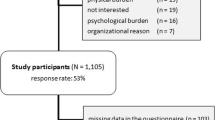Abstract
The main goal of this study was to examine depression and its components in cancer patients as compared with healthy control subjects and psychiatric inpatients. The participants were 54 cancer patients (28 females with breast cancer, 26 males with prostate cancer), 59 healthy controls (33 females, 26 males), and 75 psychiatric patients (27 females, 48 males). Participants were administered the Beck Depression Inventory (BDI) and the State Trait Personality Inventory (STPI) Depression scales. Cancer patients had higher overall depression scores than did healthy controls as measured by BDI, but the difference was due primarily to the significantly higher scores of the cancer patients on the BDI Somatic–Performance subscale. No differences were found on the BDI Cognitive–Affective subscale. Cancer patients also scored significantly higher than healthy controls on the State-Trait Personality Inventory (STPI) State Depression (S-Dep) scale because of higher Euthymia subscale scores. The psychiatric inpatients scored significantly higher than the other groups on all measures of depression. The findings of this study suggest that cancer patients may be erroneously labeled as depressed because of somatic–performance difficulties they may experience, which are similar to symptoms of depressed individuals. In addition, it is essential to delineate the various components of depression in evaluating cancer patients.
Similar content being viewed by others
REFERENCES
American Cancer Society (ACS). (1998). Cancer facts & figures–1998. Atlanta, GA: Author.
Beck, A. T., & Steer, R.A. (1987). Beck depression inventory: Manual. New York: The Psychological Corporation.
Beck, A. T., Ward, C. H., Mendelson M., Mock J., & Erbaugh, J. (1961). An inventory for measuring depression. Archives of General Psychiatry, 4, 561–571.
Berndt, D. J. (1990). Inventories and scales. In B. B. Wolman, & G. Stricker (Eds.), Depressive disorders (pp. 255–274). NewYork: JohnWiley & Sons.
Greer, S., & Morris, T. (1975). Psychological attributes of women who develop breast cancer: A controlled study. Journal of Psychosomatic Research, 19, 147–153.
Gotlib, I. H., & Cane, D. B. (1989) Self–report assessment of depression and anxiety. In P. C. Kendall & D. Watson (Eds.), Anxiety and depression (pp. 131–169). San Diego: Academic Press.
Plumb, M. M., & Holland, J. (1977). Comparative studies of psychological function in patients with advanced cancer—I. Self reported depressive symptoms. Psychosomatic Medicine, 39(4), 264–276.
Rabkin, J. G., & Klein, D. F. (1987). The clinical measurement of depressive disorders. In A. J. Marsella, R. M. A. Hirschfeld, & M. M. Katz (Eds.), The measurement of depression (pp. 30–86). New York: The Guilford Press.
Reich, J. H., & Noyes, R. (1987). A comparison of DSM–III personality disorders in acutely ill panic and depressed patients. Journal of Anxiety Disorder, 1(2), 123–131.
Ritterband, L. M. (1995). Evaluation of the Beck Depression Inventory's sensitivity and state–trait properties. Unpublished master's thesis, University of South Florida, Tampa, FL.
Ritterband, L.M.(1998). Evaluation of depression, emotional states, and personality traits in cancer patients. Unpublished doctoral dissertation, University of South Florida, Tampa, FL.
Ritterband, L. M., & Spielberger, C.D. (1996). Construct validity of the Beck Depression Inventory as a measure of state and trait depression in non–clinical populations. Depression and Stress, 2(2), 123–145.
Roberts, C. S., Baile, W. B., Elkins, N. W., & Cox, C. E. (1990). Effects of interview context on the assessment of mood in breast cancer patients: A replication study. Journal of Psychosocial Oncology, 8, 33–47.
Spielberger, C. D., Barker, L. R., Russell, S. F., Crane, R. S., Westberry, L. G., Knight, J., & Marks, E. (1979). The preliminary manual for the State–Trait Personality Inventory. Unpublished manual, University of South Florida, Tampa, FL.
Spijker, A. V., Trijsburg, R. W., & Duivenvoorden, H. J. (1997). Psychological sequelae of cancer diagnosis: A meta–analytic review of 58 studies after 1980. Psychosomatic Medicine, 59, 280–293.
Spitzer, R. L., Williams, J. B., Gibbon, M., & First, M. B. (1992). The Structured Clinical Interview for DSM–III–R (SCID): I. History, rationale, and description. Archives of General Psychiatry, 49(8), 624–629.
Stevens, D. E., Merikangas, K. R., & Merikangas, J. R. (1995). Comorbidity of depression and other medical conditions. In E. E. Beckham & W. R. Leber (Eds.), Handbook of depression: 2nd ed., pp. 147–199). New York: The Guilford Press.
Temoshok, L., & Heller, B. W. (1984). On comparing apples, oranges, and fruit salad: A methodological overview of medical outcome studies in psychosocial oncology. In C. L. Cooper (Ed.), Psychosocial Stress and Cancer (pp. 231–260).
Wolman, B. B., & Stricker, G. (Eds.). (1990). Depressive disorders: Facts, theories, and treatment methods. New York: Wiley–Interscience.
Author information
Authors and Affiliations
Rights and permissions
About this article
Cite this article
Ritterband, L.M., Spielberger, C.D. Depression in a Cancer Patient Population. Journal of Clinical Psychology in Medical Settings 8, 85–93 (2001). https://doi.org/10.1023/A:1009551809695
Issue Date:
DOI: https://doi.org/10.1023/A:1009551809695




